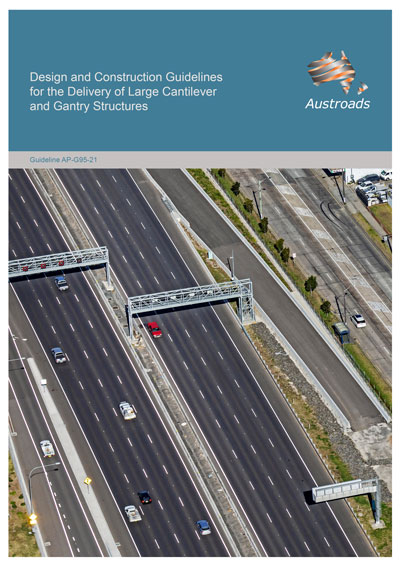Bridges

- Publication no: AP-G95-21
- ISBN: 978-1-922382-46-7
- Published: 19 January 2021
- PDF (free) Download
This guideline documents consistent advice for the design and construction of large cantilever and gantry structures that is aligned with national and international best practice.
Over recent years there have been a number of incidents of structural failures of sign and high mast lighting structures across Australia and New Zealand, primarily due to poor design and construction practices. In addition to the obvious unacceptable safety risks and property damage caused by such incidents, these failures create substantial unforeseen operational costs to repair and modify these assets. This often results in significant traffic delays and imparts reputational damage to the governing road authority and other parties involved.
An extensive literature review and stakeholder engagement process formed the basis of this project. It identified gaps in guidance in the delivery of cantilever and gantry structures, as well as examples of good practice in their design and construction and lessons learnt from past failures.
This guidance document should be read alongside relevant standards and is intended for use by all stakeholders involved in the delivery of cantilever and gantry structures including:
- state road agencies
- local government agencies
- designers, contractors and fabricators.
Watch the webinar about the report.
- Summary
- Definitions
- Abbreviations
- 1. Introduction to the Guideline
- 1.1 Introduction
- 1.2 Purpose
- 1.3 Scope
- 1.3.1 Limitations
- 1.4 Methodology
- 1.5 Guideline Structure
- 2. Delivery Approach
- 2.1 Design General Principles
- 2.2 Standards and Guidance Documents
- 2.3 Matters for Resolution
- 3. Design
- 3.1 Design Life
- 3.2 Clearances
- 3.2.1 Horizontal Clearance
- 3.2.2 Vertical Clearance
- 3.3 Deflection Limits
- 3.4 Wind Loading
- 3.4.1 Terrain Category
- 3.4.2 Solidity Ratio
- 3.4.3 Shielding Factor
- 3.4.4 Drag Coefficient
- 3.4.5 Critical Wind Loading for Wind-Induced Vibrations
- 3.4.6 Wind Loading for Fatigue
- 3.5 Dynamic Analysis
- 3.5.1 Dynamic Interaction Between a Bridge and an Attached Gantry
- 3.6 Fatigue
- 3.7 Detailing
- 3.7.1 Connections
- 3.7.2 Bolting
- 3.7.3 Welding
- 3.7.4 Holes for Drainage and Electrical Conduits
- 3.7.5 Useful References
- 3.8 Safety in Design
- 3.8.1 Responsibilities of the Design Engineer
- 3.8.2 Other Responsibilities
- 3.8.3 Safety in Design Workshop
- 3.8.4 Useful References
- 4. Construction
- 4.1 Protective Coatings
- 4.1.1 Considerations at the Design Stage
- 4.1.2 Considerations During Application
- 4.1.3 Fabrication / installation/ storage considerations:
- 4.1.4 Common Issues Impacting Durability and Function
- 4.1.5 Useful References
- 4.2 Importation of Steel
- 4.2.1 Steel Compliance
- 4.2.2 High Strength Bolt Compliance
- 4.2.3 Availability and Lead Time
- 4.2.4 Useful References
- 4.3 Common Challenges
- 4.3.1 Weld Distortion of Base / Splice Plates
- 4.3.2 Distortion During Galvanisation
- 4.3.3 Connection Constructability
- 4.3.4 Tensioning of Bolts
- 4.3.5 Installation of Lock Nuts
- 4.3.6 Gaps Between Splice Plates
- 4.3.7 Grouting Under Base Plates
- 4.3.8 Orientation and Installation of Anchor Bolts
- 4.3.9 Useful References
- 4.1 Protective Coatings
- 5. Quality
- 5.1 Design Phase
- 5.2 Construction Phase
- References
